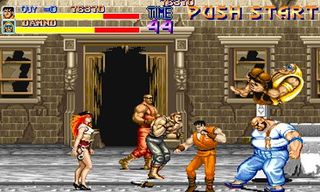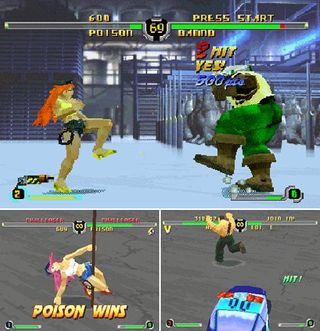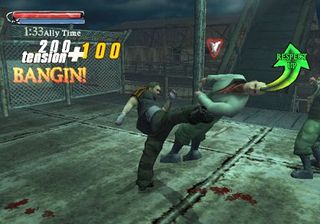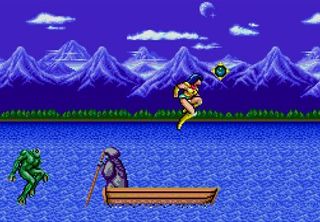Franchises that were better off dead
As these failed reboots and misguided relaunches prove, some series should just be left in the ground

The dead franchise: Final Fight (1989-1996)

Set in the crime-ridden Metro City, this side-scrolling brawler introduced players to martial arts master Cody, ninjutsu trainee Guy and hulking Mayor Mike Haggar as they cleaned up the streets with their own brand of beat ‘em-up justice. Final Fight was one of the most beloved examples of its genre, but that genre was gradually replaced in popularity by one-on-one fighting games like Street Fighter and Mortal Kombat.
Capcom still cared about the series, as evidenced by the publisher’s pair of SNES-exclusive sequels. These were quickly forgotten, however, by players now more interested in characters like Ryu and Chun-Li.

The failed resurrection, part one: Final Fight Revenge (1999)

Capcom Japan’s creative team clearly loved Final Fight, as characters from the franchise continued to appear in titles like Street Fighter Alpha and Saturday Night Slam Masters. Unfortunately, when the time came to resurrect the property, Capcom gave the job to its US development team, who seemed confused as to what they should do with it.
The first attempt was 1999’s Final Fight Revenge, a 3D fighter that was abysmal in almost every way. For starters, the game ran on Saturn-based hardware, resulting in blocky, ugly character models that bore little resemblance to the original beloved sprites. Even worse was the clunky combat – the “special” younger brother to the already unimpressive Street Fighter EX. And adding insult to injury, Revenge was one of the last Sega Saturn games ever produced, leaving system stalwarts with one stinky collector’s item.
Sole redeeming quality: The final boss, a zombified Belger from the original that does the Thriller dance over the credits if you beat the game with no continues.
Sign up to the GamesRadar+ Newsletter
Weekly digests, tales from the communities you love, and more

The failed resurrection, part two: Final Fight: Streetwise (2006)

Capcom USA’s attempts at Final Fight revivals didn’t stop there, sadly. 2006 brought the release of Streetwise, a horrendously misguided 3D brawler starring Cody’s younger brother Kyle. Streetwise missed the point in almost every conceivable fashion: Gone were the comic-like, exaggerated settings of Metro City past, replaced with gray, grim and gritty locales. The simple stories of ridding the streets of the Mad Gear gang made way for a convoluted tale involving a corrupt priest, mutation-causing drugs and dialogue peppered with “edgy” f-bombs.
Also gone is the fun, varied co-op combat of yore. Instead, we got hordes of enemies best beaten by mashing a single-button attack. Again, the sole hilariously redeeming quality is the final boss, a Resident Evil-style Cody monster. We doubt that one’s going to appear in Super Street Fighter IV.
VALIS

The dead franchise: Valis (1986-1994)

Never heard of Valis? We’re not surprised. Created by a Japanese company called Telenet in the late ‘80s and early ‘90s, this series of action/adventure games follows a schoolgirl named Yuko as she’s transported to the fantasy world of Vecanti, given a sword plus (minimal) armor and pitted against monstrous beings, sometimes with additional (female) friends fighting at her side.
Valis doesn’t hold up well by today’s standards, but the franchise managed to earn a following at the time, largely because it didn’t try to disguise or alter its anime-inspired roots… beyond the hilariously re-drawn Western box art, of course. Awareness via emulation and a boom in anime popularity kept Valis in the hearts and minds of fans long after the games stopped getting made.
Telenet’s fortunes, however, then took a strange series of turns, and in 2006, the company opted to earn some extra money by licensing its dormant properties to a smaller Japanese business called Eants – with Valis among them. Eants’s vision for a new Valis was, well… just take a look.

The failed resurrection: Valis X (2006)

Welcome to the world of eroge – erotic Japanese games that are best described as illustrated text adventures, but with voice acting and choices like “Put it in,” replacing the usual “North, South, East, West.” Yes, this is what happened to Valis. Eants took the familiar stories and recast them as episodic porn, replacing the originals’ platforming action with all-new sexy action. At last, we would find out exactly what was underneath Yuko’s armor.
Even fans who were salivating at the thought of hot lesbian play between the franchise’s heroines were quickly turned off by Valis X’s more “diverse” sexual escapades – utterly unpleasant scenarios that embodied Westerners’ worst held stereotypes of depraved Japanese hentai anime. Whatever initial anticipation existed was erased by the horrible realization that this was a fantasy that shouldn’t be realized, and especially not like this. Remember that cute girl you liked in high school? Valis X is equivalent to discovering that that girl is now performing in back alley fetish shows to support her life-ruining crack habit.
Telenet’s back catalog of games – including the Valis series – was recently sold off to a newly revitalized Sunsoft. Somehow, we doubt that Valis X was included in the deal.
Feb 3, 2010


They had it. They lost it. Here they are

Awful game twists that nearly ruined everything, before and after

Gaming stars who went under the knife for drastic redesigns
GamesRadar+ was first founded in 1999, and since then has been dedicated to delivering video game-related news, reviews, previews, features, and more. Since late 2014, the website has been the online home of Total Film, SFX, Edge, and PLAY magazines, with comics site Newsarama joining the fold in 2020. Our aim as the global GamesRadar Staff team is to take you closer to the games, movies, TV shows, and comics that you love. We want to upgrade your downtime, and help you make the most of your time, money, and skills. We always aim to entertain, inform, and inspire through our mix of content - which includes news, reviews, features, tips, buying guides, and videos.
Most Popular




